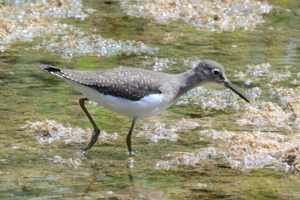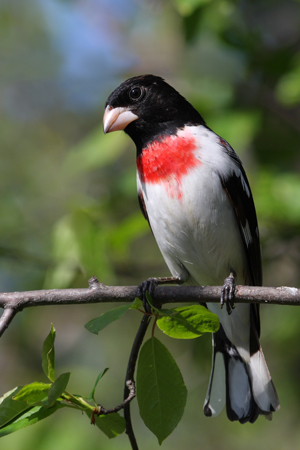Story and photos by Michelle Sutton unless noted
Keep straight down this block,
Then turn right where you will find
A peach tree blooming.
—Richard Wright

“We love what we pay attention to.” It’s why we love our gardens so much. For just over a year, I’ve also been paying close attention to a patch of swampland, scrub, and forest behind my neighborhood. I never used to; for most of the years I’ve lived here, it was land rented by a gun and rod club, so I didn’t think of it as public space. But, fortuitously, the owner of the land sold it last year to a conservancy and with that, the land beckoned.
It was especially serendipitous because I needed a nearby place to practice my new hobby of birding. Through social media, I’d become acquainted with the dynamic urban forester, independent researcher, and writer Georgia Silvera Seamans (@localecologist on Instagram). Georgia is the director of Washington Square Park Eco Projects in Manhattan; she introduced me to the concept of “patch birding”—birding regularly at a spot close to home. I highly recommend her article on Audubon.org, “Want a Training Ground for Your Birding Skills? Try Patch Birding” and her podcast, Your Bird Story. Through her work, she explores the many layers of benefits nearby nature provides. Georgia’s patch is Washington Square Park.
My chosen patch in the now-nature preserve so close to me turns out to be a stopover for spring migrants, like kinglets, warblers, thrushes, grosbeaks, tanagers, green herons, and shorebirds. I’ve seen many bird species for the first time in this spot that’s a three-minute walk from my house. I’ve also seen muskrats, turtles, a beaver, and a black bear who came down from the woods to the swamp to have a drink.

In her nearby patch, the author had her first sighting of many bird species, such as:
black-throated blue warbler (Alexandre Légaré, Wikimedia) 
solitary sandpiper (Mark Nenadov, Wikimedia)
rose-breasted grosbeak (Cephas, Wikimedia)
My recent patch birding adventures got me thinking about past nearby nature experiences. When I was a student at Virginia Tech in the mid-90s, my then-partner and I would go to a patch of woodland—about two acres, recommended by beloved horticulture professor Dr. Robert Lyons—on the outskirts of Blacksburg, where the diversity of spring wildflowers merited at least a weekly visit. We started with discovering the alien-looking ground-hugging flowers of skunk cabbage in the spring and ended with admiring delicate dancing white asters in the fall. The regular visits gave us a fabulous education and were my doorway into observing wild nature more closely.
A cultivated place can also be a patch for nature study. When I lived within walking distance of Highland Park in Rochester, I tended to linger at certain spots, like the carpet of early spring blue scillas (Scilla siberica) under the linden (Tilia) tree near the west end of the Reservoir, the Poet’s Garden with its rivers of long-blooming hellebores (Helleborus), the truly wild-looking late spring white bracts of the handkerchief tree (Davidia involucrata) behind and uphill from the Highland Bowl, the darkest-purple blooming lilacs on the lilac hill, and the always-inspired tulip and annual beds. In my frequent visits to Highland Park, I was immersing myself in nearby nature.
When I worked in the education department at Cornell Botanic Gardens (CBG), there was a mature bigleaf magnolia (Magnolia macrophylla) outside my office window, and, just beyond, a truly sumptuous river of European ginger (Asarum europaeum), which remains my favorite ground cover. How many times did I look out the window and draw inspiration from the implausibly tropical-looking bigleaf magnolia tree, and on my breaks walk over to the shiny European ginger, entranced and soothed by its perfection? How many times did I stop at the rock garden to look at the impossibly symmetrical and tidy alpine cushion plant (Silene acaulis)?
As an educator I also became intimate with the denizens of the Mundy Wildflower Garden at CBG. Retired elementary school teacher–volunteers and I developed a program called “Wildscience” for third and fourth graders in Ithaca. To prepare the kids for their visit to the Wildflower Garden, we first went into the classroom with three activities: dissecting a flower (gladiolus) and mounting the parts; drawing the stages of a plant’s life cycle; and sorting through a bin of ginger root, potatoes, and flower bulbs to learn the different underground structures of rhizomes, tubers, and bulbs in wildflowers. Then we left “wildflower passports” with them, which prompted them to learn about one wildflower in particular so they could share their new knowledge with the rest of the class on tour day. When they arrived, we gave them a Spring Wildflower Guide and a golf pencil to take notes and do field drawings.

eBird, developed by the Cornell Lab of Ornithology and the standard bearer for global tech-assisted citizen science, shows where the birding hotspots are—and public gardens, arboreta, and cemeteries are among them. Once you know the plants collections in these places well, birding adds another dimension to your visits.
In Monroe County, birders have encountered 357 species of birds; the hotspot with the most species observed (282) is at Hamlin Beach State Park—a place to see migrating birds going to or coming from their summer breeding grounds in Canada—but other contenders include Durand-Eastman Park (192 species), Highland Park (172 species), Mount Hope Cemetery (135), and Webster Arboretum (132).
In Erie County, 340 species have been observed, with some public garden hotspots like Forest Lawn Cemetery (205 species), Delaware Park (158 species), and Buffalo Botanical Gardens (150) contributing meaningfully to the County’s data.
In Onondaga County (313 species), Thornden Park—perhaps best known to UGJ readers for its rose garden—is a birding hotspot, with 123 species sighted there. And in Tompkins County, there is a very high number of hotspots—482 places—from which birders have collectively seen 343 species.
The USA National Phenology Network’s program, Nature’s Notebook, is another great way to get more attuned to wild and/or cultivated nature. Much like eBird for birding, Nature’s Notebook is a network of citizen-scientist observers; in this case, the observations are of phenological phases (budding, flowering, leaf drop, etc.). Like eBird, Nature’s Notebook has a user-friendly mobile app for those who want to enter data while in the field. In New York State, there are more than 500 plant species that Nature’s Notebook observers are collecting data on, including American basswood (Tilia americana), Alleghany serviceberry (Amelanchier laevis), tupelo tree (Nyssa sylvatica), northern spicebush (Lindera benzoin), rugosa rose (Rosa rugosa), swamp milkweed (Asclepias incarnata), and 14 species of oak. Some of the 500 species are surely in your own yard or adjacent woodlot—nearby nature, indeed.

For nearly ten years, a ‘Sum and Substance’ hosta grew in a shady corner outside our house … where no one could see it. Motivated to create a new garden with only plants I already had, I relocated the hosta, a currant bush, red-twig dogwoods, and sedges into the new bed. We watched the unfurling of the ‘Sum and Substance’ leaves much more closely this year. As I write this, it’s a washout of a day; I’m watching a pair of robins repeatedly dart for cover under the big chartreuse leaves when the rain intensifies, then intrepidly run back out when the rain lets up. What could be sweeter?

THE HAIKU OF RICHARD WRIGHT
Author of the seminal novel Native Son and memoir Black Boy, American author Richard Wright began writing Haiku in the last eighteen months of his life, when he was home-bound and struggling to overcome an extended illness. One imagines that connecting to nearby nature through observation and poetry was one way he coped with the brutal situation in which he found himself. The Richard Wright papers at the Yale Beinecke Library—which released this photo—contain hundreds of the more than 4000 Haiku poems Wright wrote. Here is a sample.
A soft wind at dawn
Lifts one dry leaf and lays it
Upon another.
Like a spreading fire,
Blossoms leap from tree to tree
In a blazing spring.
All right, You Sparrows;
The sun has set and you can now
Stop your chattering!
An apple blossom
Trembling on a sunlit branch
From the weight of bees.
Leaving its nest,
The sparrow sinks a second,
Then opens its wings.
They smelt like roses;
But when I put on the light,
They were violets.
Richard Wright papers at the Yale Beinecke Library
Michelle Sutton is a horticulturist, writer, and editor.
Views: 0






